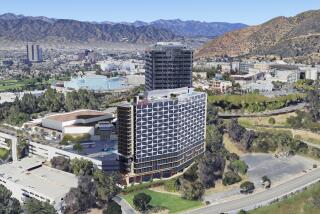Results mixed in Westside measures on development
Westside voters delivered a somewhat mixed message on development in Tuesday’s election, leaving the fate of a hotel-and-condo project in Beverly Hills too close to call and defeating a proposed cap on commercial construction in Santa Monica.
In Beverly Hills, supporters and opponents split the vote almost equally on whether to allow expansion of the Beverly Hilton complex.
As of Wednesday, the anti-Measure H side had edged out the pro side by 68 votes. But the Hilton and its owner, Beny Alagem, were not conceding because an as-yet-unknown number of ballots were still uncounted.
“The election for Measure H is not over until every vote is counted,” said Marie Garvey, a Hilton spokeswoman.
Grace Chavez, a spokeswoman for the Los Angeles County registrar’s office, said her office would issue a Measure H update Friday.
About 375,000 provisional and mail-in ballots from throughout the county had yet to be processed, she said.
Some of those might be from Beverly Hills voters. The Hilton said resolution of the issue could take as long as two weeks.
The Hilton is seeking an amendment to the city’s general plan so it can build a 12-story Waldorf-Astoria hotel and two condominium towers at its site at the busy corner of Wilshire and Santa Monica boulevards.
Opponents contend that the project is too big.
The issue sparked a contentious community debate about traffic and development. The Hilton has spent about $3 million since last spring to drum up support. Opponents mustered about $82,000.
In Santa Monica, Measure T, aimed at limiting development and curbing future traffic congestion, was roundly trounced, with nearly 56% of voters opposed. Still, 14,170 voters favored the proposal, which would have limited development of hotels, shops and offices to 75,000 square feet a year, about half the current level.
That support revealed the depth of concern about traffic and overdevelopment, said Diana Gordon, a spokeswoman for the Santa Monica Coalition for a Livable City.
“We were proposing a fundamental change in how much development a city should approve and how to pace it,” said Gordon, who helped create the citizens initiative that gave rise to the ballot measure.
Developers, including several from outside California, and related interests reached deep to fight the measure. All told, opponents spent more than $800,000.
--
More to Read
Sign up for Essential California
The most important California stories and recommendations in your inbox every morning.
You may occasionally receive promotional content from the Los Angeles Times.











